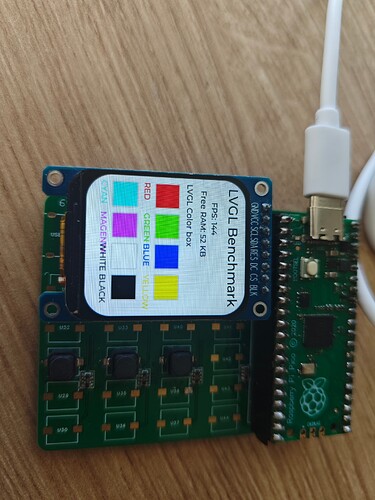I’m using lv-micropython from GitHub - lvgl/lv_micropython: Micropython bindings to LVGL for Embedded devices, Unix and JavaScript. The commit ID is 233ef84925774ced5778510e97f529c8936b4f5a, which is the newest commit as of the time of this problem.
I built the firmware using the following commands:
make -j -C mpy-cross
make -j -C ports/rp2 BOARD=RPI_PICO USER_C_MODULES=…/…/user_modules/lv_binding_micropython/bindings.cmake
I’ve checked that the color depth is 16.

When I set the color on the screen, the data in the buffer is not what I expected.
I used the following script for testing:
import lvgl as lv
import time
_current_test_color = 0
_flush_done = False
def _disp_flush(disp, area, color_ptr):
print(area)
print(color_ptr)
"""Internal flush callback - do not call directly"""
global _flush_done, _current_test_color
if _flush_done:
disp.flush_ready()
return
# Calculate area information
x1, y1, x2, y2 = area.x1, area.y1, area.x2, area.y2
pixel_count = (x2 - x1 + 1) * (y2 - y1 + 1)
data_len = pixel_count * 2 # 2 bytes per RGB565 pixel
# Read buffer data
read_data = bytearray(data_len)
lv.memcpy(read_data, color_ptr, data_len)
# Get expected values
expected = _current_test_color
exp_byte1, exp_byte2 = expected & 0xFF, (expected >> 8) & 0xFF
# Print test results
print("=" * 50)
print(f"Testing color: 0x{expected:04X}")
print(f"Area: ({x1},{y1}) to ({x2},{y2}) | Pixels: {pixel_count}")
print(f"Expected bytes (little-endian): 0x{exp_byte1:02X} 0x{exp_byte2:02X}")
# Check first 3 pixels
print("\nFirst 3 pixels:")
match = True
for i in range(0, min(6, data_len), 2):
b1, b2 = read_data[i], read_data[i+1]
actual = (b2 << 8) | b1
status = "OK" if actual == expected else "ERROR"
print(f"Pixel {i//2+1}: 0x{b1:02X}{b2:02X} or 0x{actual:04X} ({status})")
if actual != expected:
match = False
# Final result
print("\nResult:", "✅ All match!" if match else "❌ Mismatch detected")
print("=" * 50)
_flush_done = True
disp.flush_ready()
def test_color(color_hex):
"""
Test LVGL buffer data for a given color value.
Args:
color_hex: RGB565 color value in hex format (e.g., 0xF800 for red)
"""
global _current_test_color, _flush_done
# Reset global state
_current_test_color = color_hex
_flush_done = False
# Initialize LVGL
lv.deinit()
lv.init()
# Buffer configuration (240x70, RGB565)
buf_w, buf_h = 240, 70
buf_size = buf_w * buf_h * 2
buf = lv.malloc(buf_size)
# Display setup
disp = lv.display_create(buf_w, buf_h)
disp.set_buffers(buf, None, buf_size, 0)
disp.set_flush_cb(_disp_flush)
# Set screen color
scr = lv.screen_active()
scr.set_style_bg_color(lv.color_hex(color_hex), 0)
scr.set_style_bg_opa(lv.OPA.COVER, 0)
# Trigger refresh
lv.timer_handler()
time.sleep_ms(10)
# Cleanup
lv.free(buf)
if __name__ == "__main__":
# Test a variety of colors to find potential patterns in errors
test_colors = [
0xF800, # Red
0x07E0, # Green
0x001F, # Blue
0xFFE0, # Yellow (Red + Green)
0xF81F, # Magenta (Red + Blue)
0x07FF, # Cyan (Green + Blue)
0xFFFF, # White
0x0000, # Black
0x8410, # Gray 50%
0x4208, # Gray 25%
0xC618, # Gray 75%
0x0400, # Dark green
0x0008, # Dark blue
0x8000, # Dark red
0x7BEF, # Light blue
0xFDA0, # Pink
0xBDF7, # Light purple
0x821F, # Teal
0xEF5B, # Orange
0x94B2 # Brown
]
test_color(test_colors[0])
test_color(test_colors[1])
test_color(test_colors[2])
#for color in test_colors:
# test_color(color)
# time.sleep_ms(50)
the output is:
>>> %Run -c $EDITOR_CONTENT
MPY: soft reboot
struct lv_area_t
C Array (uint8[])
==================================================
Testing color: 0xF800
Area: (0,0) to (239,69) | Pixels: 16800
Expected bytes (little-endian): 0x00 0xF8
First 3 pixels:
Pixel 1: 0xC007 or 0x07C0 (ERROR)
Pixel 2: 0xC007 or 0x07C0 (ERROR)
Pixel 3: 0xC007 or 0x07C0 (ERROR)
Result: ❌ Mismatch detected
==================================================
struct lv_area_t
C Array (uint8[])
==================================================
Testing color: 0x07E0
Area: (0,0) to (239,69) | Pixels: 16800
Expected bytes (little-endian): 0xE0 0x07
First 3 pixels:
Pixel 1: 0x3C00 or 0x003C (ERROR)
Pixel 2: 0x3C00 or 0x003C (ERROR)
Pixel 3: 0x3C00 or 0x003C (ERROR)
Result: ❌ Mismatch detected
==================================================
struct lv_area_t
C Array (uint8[])
==================================================
Testing color: 0x001F
Area: (0,0) to (239,69) | Pixels: 16800
Expected bytes (little-endian): 0x1F 0x00
First 3 pixels:
Pixel 1: 0x0300 or 0x0003 (ERROR)
Pixel 2: 0x0300 or 0x0003 (ERROR)
Pixel 3: 0x0300 or 0x0003 (ERROR)
Result: ❌ Mismatch detected
==================================================
>>>
The result shows a color channel mismatch and a bit level mistake.
